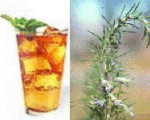Search engine visitors - click here to access entire "$ensible Home" web site
Unlike my regular format, there is no column associated with this bulletin because it did not appear in the newspapers. The following is the introduction from the actual Update Bulletin No. 971.

An easy-to-grow tea garden planted with a variety of herbs can provide an abundance of leaves that may be enjoyed fresh from the garden or dried for a winter supply of comforting teas. Herbal teas are very nice to sip in the evenings as they are caffeine-free.
To brew natural teas, bring fresh, cool water to a rolling boil. Rinse a teapot (do not use metal) with some of the water to warm it, then toss in the herbs. Generally you should use 2 tablespoons of fresh or 1 tablespoon of dried herbs for each cup of water. Then add an additional 2 tablespoons of fresh or 1 tablespoon of dried herbs for the pot. You may want to use an infuser to hold the herbs.
Pour the boiling water over the herbs and let steep for about 3 to 5 minutes. Keep the pot covered to retain heat. Brewing time can vary, depending on herbs used and your particular taste. Keep experimenting until you find the taste you prefer. Strain the herbs out as soon as the tea is ready. It can be served as is or you may want to sweeten it with honey. Add lemon or orange slices.
A nice touch is adding sprigs of fresh herbs to the tea. For iced tea, follow the same directions, increasing the amount of herbs to 3 tablespoons fresh or 2 tablespoons dried herbs. It needs to be stronger to allow for the ice melting. Herbs can also be frozen in ice cubes that can be added to the tea or other drinks. Experiment with different blends. Try two, three or even four different herbs together.
Instant Download Update Bulletin No. 971 - selection guide and growing instructions for 15 herbs to brew teas, plant types (annual, biennial, perennial), flower color, flower shape, plant size, spacing, bloom times, recommended soil conditions, harvesting/drying methods, zones and hardiness map, instructions and illustrations on designing an Elizabethan Knot Garden and other garden designs.